
Feeding Farm Animals Effectively
November 19, 2024, 10:21 am
Animal feeding is the act of consuming food or the act of supplying food and nourishment to farm animals.
Herbivores such as rabbits, sheep, goats, camels, cattle, horses, buffaloes, grasscutters etc. generally thrive on forage diets but feeding a supplement (grains or concentrate) ensures that the animals receive all the nutrients that they need.
Feeding Farm Animals Effectively
Sheep, goats, cattle and horses can be taken out for grazing or may be fed by zero grazing whereby forage (edible herbs) are cut and brought to pens and stables.
Hay can also be provided on hay racks. When forages are harvested for immediate feeding, it is known as soilage.
Slop-feeding is a system of feeding animals whereby dry feeds are mixed with water or milk to form slurry and this mixture is fed to animals. This system is common in the fattening of pigs and cattle. In cattle feeding, corn bran is mixed with water.
Feeding is about the most expensive item in livestock production and it accounts for 60% to 70% of production costs.
TYPES OF FEED USED BY LIVESTOCK AND POULTRY
Roughages
This is obtained from grasses and legumes. They are available in raining season but not in dry season. Silage, hay-making or preparation of supplementary feeds is done towards dry season.

Hay
Crop residues like corn, sorghum, and groundnut or millet stover are sun dried as feed for animals. The materials should be cut at early stage of maturity. Addition of carotene is necessary as vitamin A might be lost during sun drying
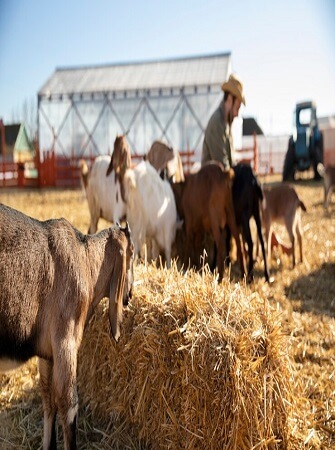
Silage
Fairly wilted crop residues are used for silage, to ensure that adequate sugar is in the material, molasses could be added. The stems are trampled down or crushed to remove hollow in them, they are then chopped for easy compaction. Trenches that are lined with polyethene or banana leaves are made.
The chopped forage is put into the pit in layers with adequate compaction to exclude air, heavy animals or tractor can be used to compact silage. Silage can last for years if well prepared.
Concentrate
Poultry raised in intensive system is usually fed with well compounded concentrates.

Pigs and rabbits are fed a combination of forage and concentrates. Concentrate feed can be presented in three forms:
- Meal: ground cereal or legume seed
- Mash: combination of meals mixed in particular proportion
- Pellets: dried semi-solid crumbs
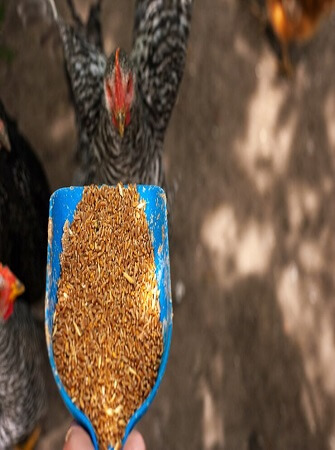
Grasscutters are also fed with forages and supplements as well as kitchen wastes. Snails are fed with vegetable diets and kitchen waste
Stovers
These are mature, sun dried stalks from which seeds have been harvested e.g. maize, guinea corn, groundnut
FEEDING RUMINANTS
A ruminant possess complex stomach which is divided into four parts namely: the rumen, the reticulum, the omasum and the abomasum. The rumen and the reticulum form the larger parts of the stomach and have a temperature of 39°C to 40°C, and Ph 4.5 to 7.0.
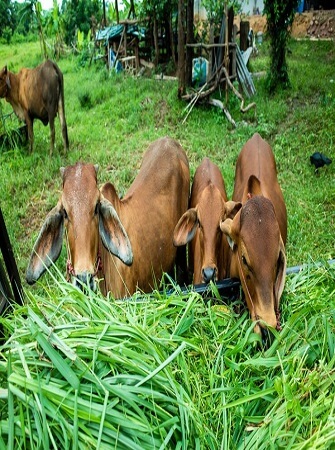
There is little or no oxygen in the rumen, therefore, the rumen is said to be anaerobic and it is the home for a large number of microorganisms which give the rumen the ability to digest cellulose and the ability to use non-protein nitrogen like urea as raw material for protein synthesis.
Also, the microorganisms give the ruminant the characteristics to exist without dietary sources of B-complex and vitamin K. Therefore, ruminants can survive on low protein and high roughage.
Feed intake, which is the amount of forage that an animal will voluntarily consume, depends on:
- Availability and age of herbage
- Period spent grazing
- Water availability
- Weather conditions e.g. high environmental temperature leads to reduced intake of food but leads to high water intake
- State of health of the animal
- Age of animal and production status
However, concentrate feeds can be supplemental to meet the nutritional requirements of the animals
FARM ANIMAL APPETITE
The instinctive desire for feed or drink is known as appetite. It is the degree of disposition towards consuming feed and water. Appetite is not the same as hunger. A hungry animal might not have the disposition to consume feed. There are internal and external stimuli involved in developing appetite.

Appetite for feed is generally controlled by the central nervous system. Although animals eat to meet their energy needs, there are situations when highly palatable diets often cause an animal to overeat while unpalatable diets are not well accepted even when the energy requirements of the animal is not met. Animal may lose appetite due to sickness or at oestrus (heat) period.
FARM ANIMAL ANOREXIA
Anorexia is a lack of appetite or off feed. It is a condition of low feed intake or complete absence of the desire to eat food which might be due to disease conditions, non-nutritive food, environmental situation (weather etc.) or mental disorder.
ANTI-NUTRITIONAL FACTORS
There are anti-nutritional compounds in some feeds. Anti-nutritional compounds are feed components that have negative effects on the intake or utilization of feed. These anti-nutritional compounds might be toxic to the animal. Some phyto-oestrogens, which are plant nitrogen containing compounds affect reproduction and so if the plant is consumed, can cause low fertility.
In the cassava leaves and roots, there is hydrocyanide (HCN), which is toxic (poisonous) to non-ruminants. Efforts to reduce the HCN content to non-toxic level include ensiling the leaves.

This can be done by mixing freshly harvested cassava leaves with rice bran and packing it into a pit, and cover with banana leaves and then weight down by stone to eliminate air and leave it for about 15 days.
The leaves can also be sundried for about 48 hours. The roots can be soaked in water and later sundried to reduce HCN. Ruminants however have microorganisms in their rumen which appear to detoxify some hydrocyanide into non-harmful compounds.
In soybean, there is trypsin inhibitor which negatively interferes with the digestion of protein. In poultry, trypsin inhibitors cause pancreas enlargement and reduce feed efficiency and growth rates. In pigs and calves, growth rates are depressed from reduced protein digestibility. To neutralize the anti-trypsin factor, soybean can be roasted although this might not ensure complete removal.
The best way to remove the trypsin inhibitor is to soak the beans for 24 hours and then boil for 30 minutes. It is therefore important to process soybean very well before feeding to animals. Some browse trees also have anti-nutritional compounds.
ANIMAL FEED DIGESTIBILITY
Digestibility is the breaking down of animal feeds into simple forms. Protein are broken down into amino acids, and carbohydrates into simple sugars, fat and lipids into fatty acids and glycerol.

FEED CONVERSION RATIO
The capacity to digest and assimilate feed is measured by dividing the amount of feed eaten by the animals over a given period liveweight increase (amount of weight gained). The result of this calculation is known as feed conversion ratio or factor (FCR).
For example, if in one week a rabbit consumed 490g of concentrates and it gained 84g of body weight. The feed conversion ratio (FCR) is calculated:
FCR = Feed intake (g) ÷ Body weight gain (g) = 490 ÷ 84 = 5.83
The lower the feed conversion ratio (FCR) value, the better the feed is utilized and conversely, the higher the FCR value, the lower the feed is utilized i.e. the poorer the feed
SOME OF THE FORAGES THAT CAN BE FED TO LIVESTOCK
Elephant grass (relished by grasscutter in particular), guinea grass, giant star grass, euphorbia (relished by pigs), maize stalk, rice stalk and legumes like stylosanthes.
Other feed items include sugarcanes and its byproducts e.g. molasses (obtained from processing of sugarcane stalk to sugar), reject or surplus banana and plantain, sweet potato, vines, palm kernel cake, cassava roots and leaves.

Cooking sweet potato improves the feeding value of the tubers for pigs and poultry as it reduces trypsin inhibitors and improves starch digestibility. Citrus, pineapple pulp (from juice manufacturing factories), wheat offals, rice bran, maize, sorghum stovers can be used as supplments.
ANIMAL FEEDING TIPS
It is important to maintain good quality of feedstuff. Livestock would reject feed soiled with their wastes. Grasscutters should not be fed ripe fruits or immature forage while they should be given supplementary feed later in the day after being fed with forage in the morning.
Keep rats away from animal feed; apart from soiling the feed and feeding on it, they can also infect animals with diseases thereby causing great economic losses. Feeding and watering troughs and mangers should be cleaned out and washed daily.
Grazing animals should not be allowed out early in the morning. Wet grass can cause digestive problems. Some poisonous grubs would still be hanging on wet forage in the early hours of the day.

Lush, young pasture can cause bloat which constitutes discomfort in grazing animal. Feed should be changed gradually. Special care must be taken in introducing new feed.
FARM ANIMAL BLOATING
This is the accumulation of gas (methane, carbon dioxide) in the rumen such that the animal is unable to eliminate gas.
Good feed is balanced in nutrients and will therefore, provide all that the body needs for growth and reproduction. Mineral blocks are also fed to livestock. It is often made available in the form of salt-lick. It has different shapes and colors.
Salt-lick should be provided on daily basis for ruminants by placing it in the feeders. Dropping salt-lick in water is not ideal. Excessive intake of the salt-lick from the water may be detrimental to the animals and cause economic loss to the owner. Salt-lick can be made locally by using indigenous mineral sources
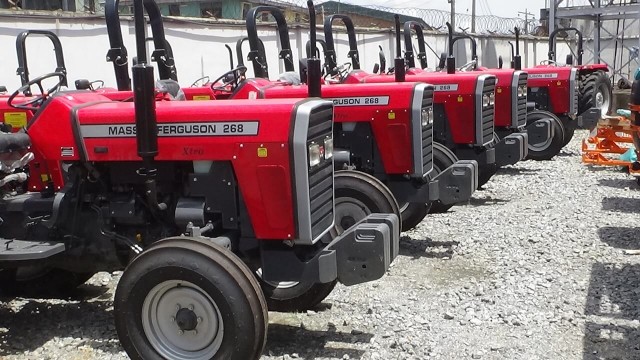

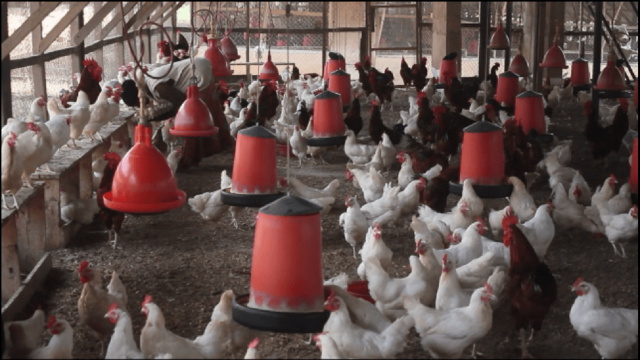

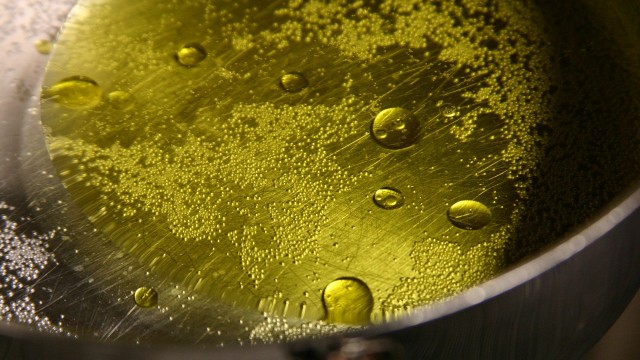





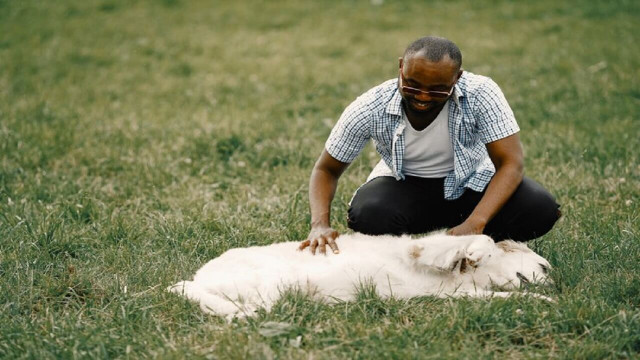

Share This Article: